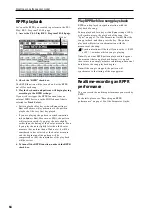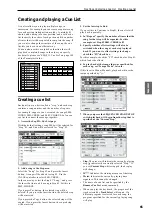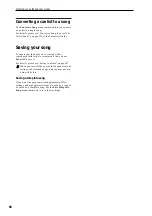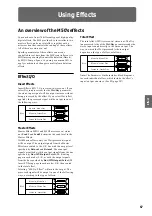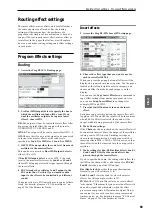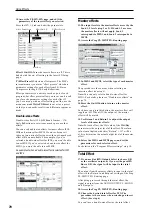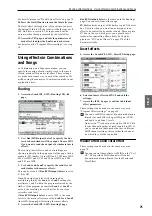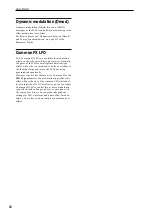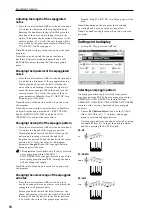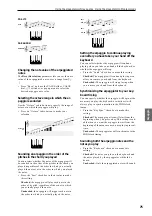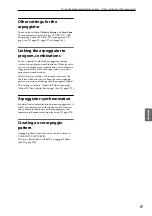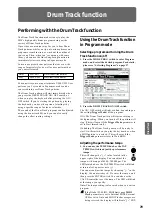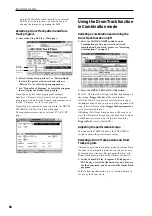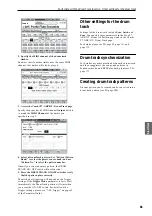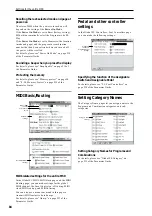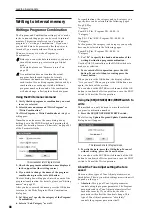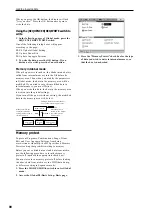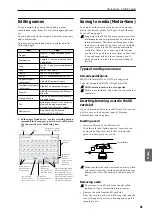
Arpeggiator function
76
Using the arpeggiator in
Combination mode
In Combination mode the M50 provides dual
arpeggiators, allowing you to run two arpeggio
patterns simultaneously.
1. Press the COMBI switch to enter Combination
mode, and select a combination. For details, please
see “Selecting Combinations” on page 43.
As you select various combinations, you will notice
that the ARP ON/OFF switch LED will light for
some combinations. For details, please see “Linking
the arpeggiator to program, combinations” on
page 77. When you press the keyboard, the arpeg-
giator will start.
For other combinations, you can press the ARP
ON/OFF switch (the LED will light) to turn on the
arpeggiator.
2. As described in the preceding section “Settings
using controllers” and the following section
“Settings in the display,” move the controllers or
modify the parameters to change the way in which
the arpeggios are played.
The ARP ON/OFF switch, TEMPO knob, TAP
TEMPO switch, and control surface ARP will
apply to both arpeggiators A and B. Their state is
saved when the combination is written.
Settings in the display
• In Combi P0: Play, press the ARP A tab.
Select the arpeggiator(s) that will run
Use the Arpeggiator Run check boxes to specify the
arpeggiator(s) that you want to have running. The
arpeggiator(s) that are checked here will operate when
the ARP ON/OFF switch is on. However, the
arpeggiator will only play a timbre if the table next to
the check boxes assigns arpeggiator A or B to a timbre:
T 1–16. You make these settings in Combi P7: ARP/
DT– ARP Setup T01–08, T09–16 page Arpeggiator
Assign
(see PG page 107).
Arpeggiator-A, Arpeggiator-B
For each arpeggiator A and B, you can make settings
for Pat (Pattern Select), Reso (Resolution), Octave,
Sort
, Latch, Key Sync, and Keyboard. (see PG
page 108)
Checking the structure of a user arpeggio
pattern
Let’s see how the combination “C015: Skippy Wants to
Dance!” (category: LeadSplits) is constructed.
• Select combination “C015: Skippy Wants to Dance!”
(category: LeadSplits), and look at the Arpeggio
Play A page and Arpeggio Play B page.
• As you can see from the “Timbre Assign” table,
arpeggiator A is assigned to timbre 3, and
arpeggiator B is assigned to timbre 5 and 8.
When you play the keyboard the arpeggiator B will
play the program assigned to timbre 5 (Timbre 8 is a
dummy timbre used to operate Timbre 5) (see PG
page 110). Arpeggiator A will play the program
assigned to timbre 3.
• If you uncheck Arpeggiator Run A or Arpeggiator
Run B
, it will stop.
If you check it once again and play the keyboard,
that arpeggiator will begin running.
• Look at the Combi P7: ARP/DT– ARP Scan Zone
page, and you will see that the A keys Top Key and
Bottom Key
are set so that arpeggiator A will
operate only for keys B3 and lower, and that the B
Top Key
and Bottom Key are set so that arpeggiator
B will operate only for keys C4 and higher.
Timbre Assign
Содержание EASYSTART M50
Страница 1: ...3 E Owner s Manual ...
Страница 84: ...Arpeggiator function 78 ...
Страница 88: ...Drum Track function 82 ...
Страница 92: ...Settings for the entire M50 86 ...



